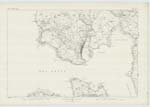OS1/23/22/85
| List of names as written | Various modes of spelling | Authorities for spelling | Situation | Description remarks |
|---|---|---|---|---|
| STANDING STONE [Howe] | Standing Stone Standing Stone Standing Stone |
Mr. Francis Taylor Farmer Howe Mr Allan Ripley Farmer Congesquoy Mr Robert Taylor Farmer Bu' Cairston |
106 | A rude block of hard unpolished stone on which there is no mark of an instrument; without carving, inscription, or hieroglyphics and is plainly the monument of an early age when people were ignorant of arts and letters. It stands about 6ft. above ground about 2 1/2 in breadth, and nearly a foot thick and is about the same measurement at the top as it is at the surface of the ground; is situated in an arable field on an eminence commanding an extensive view and opposing the "Standing Stones" of Stenness its distance is about 1/2 mile north of "Howe" Farmhouse, close to the public road leading from "Stromness" to "Kirkwall" and about 1/2 mile N.N.West of the "Bridge of Waith" This stone is supposed to be of the same origin as those of Stenness and various others throughout "Orkney" and for what purpose or what design they were erected, antiquity furnishes us with no account, records are silent, and tradition, to which recourse must be sometimes had, in the penury of other evidence, ventures not in this case to hazard an opinion Some have supposed them intended to mark spots that contained the bones, or the ashes, of a beloved prince, a brave chieftain, or a dear-departed friend, or to serve as a boundary between the territories of one great chief and another, while others again imagined them designed to perserve the remembrance of some noted event, that concerned the safety, the honour, or the advantage of the community; since no tumuli, urns, or graves, have ever been found near them they cannot certainly be considered as memorials of the dead, nor is it more likely that they were intended to mark the limits of contiguous proprietors as landmarks, objects equally well calculated to serve the purpose, could have been erected with infinitely less labour. If therefore they were not intended to serve the purpose of places of worship they were most likely raised to perserve the remembrance of some fortunate event, or perpetuate the memory of some noble action; and the rough simplicity of their appearance sufficiently justifies us in referring them to an early age and to the first inhabitants of the Orkney islands, Abridged from"Peterkin's Notes of Orkney". |
Continued entries/extra info
Parish of Stromness OrkneySigned Kenneth Campbell C/A
Transcribers who have contributed to this page.
Quakecity
Location information for this page.
Linked mapsheets.




